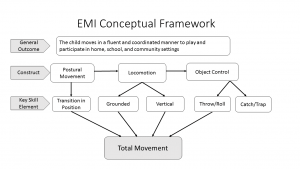The Early Movement Indicator (EMI)
The Early Movement Indicator (EMI) is one means of checking children’s growth toward the important general outcome of being able to move in a fluent and coordinated manner to play and participate in home, school, and community settings.

You can read more about IGDIs by reviewing our list of publications. To buy toys for administering the EMI, see our toys needed page. You can also find tips for IGDI administration including administering IGDIs remotely on our site.
EMI Key Skills
One way for early interventionists to measure progress toward proficiency in early movement in infants and toddlers is the Early Movement Indicator (EMI). The EMI is a play-based observational measure of a child’s movement during a 6-minute play period with specific EMI toys and a familiar adult.
The five movement skills that make up the EMI are based on a conceptual review of the literature followed by validation with other criterion measures of movement and motor ability for children this age (see Technical Soundness). The five key skill elements are:
- Transition in Position
- Grounded Locomotion
- Vertical Locomotion
- Throw/Roll
- Catch/Trap
These skills were selected to represent the postural movement domain (Transition in Position), the locomotion domain (Grounded and Vertical), and the object control domain (Throw/Roll, Catch/Trap); three skill classes that are important for children who are just acquiring movement skills. The rates of occurrence of these key skills form a single indicator of Total Movement.

